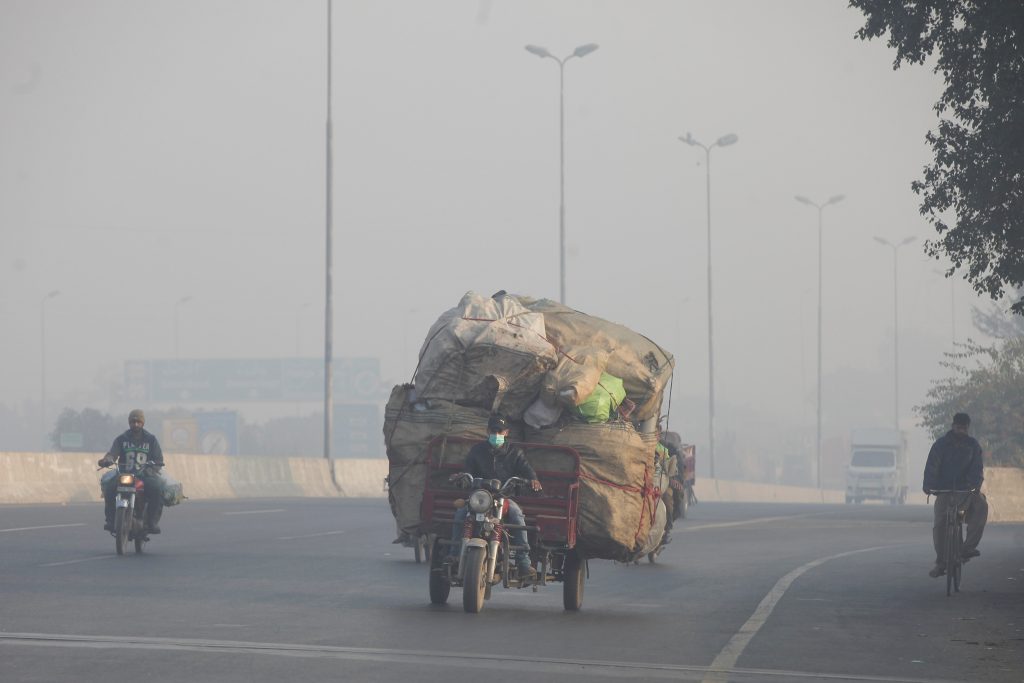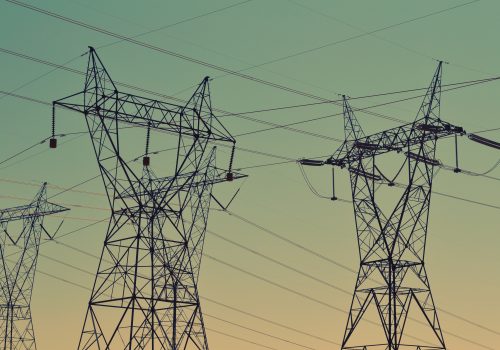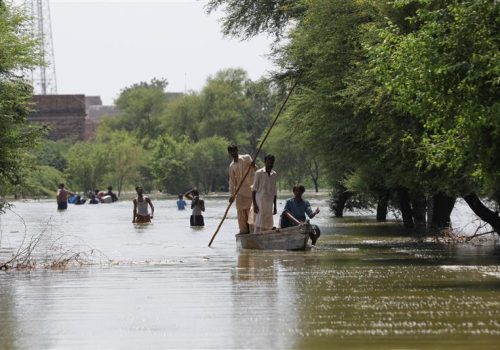This northern summer has highlighted the transnational nature of the climate challenge. Wildfires in Canada have rendered air in the United States unbreathable, while heatwaves have killed citizens on both sides of the Rio Grande. South Asia is no stranger to such phenomena: Cyclone Biparjoy was, at one point, forecast to almost perfectly bisect Indian and Pakistani territory, albeit lands that are generally sparsely populated.
By luck or providence—even secular Karachiites, half-jokingly, repeatedly invoked the spirit of Abdullah Shah Ghazi in the week before the cyclone was to hit—Pakistan was spared the worst of Biparjoy. And while India was not so lucky as to avoid it completely, the damage it meted out was considerably less intense than initially predicted.
The cyclone highlighted the negligible level of cooperation between the Indian and Pakistani governments on climate issues. Despite its geographic trajectory, the days before the cyclone made landfall saw no communication, collaboration, or coordination between Islamabad and New Delhi, or even among the state governments most likely to be affected—Sindh and Gujarat. And while it is notable that Pakistan used data from the Indian Meteorological Department, which is better equipped than Pakistan’s, neither side acknowledged this help. More importantly, had the cyclone hit more densely populated border areas, each country would have handled its own disaster response.
This siloed strategy for dealing with Biparjoy is emblematic; the lack of a joint approach to climate disaster management reflects a wider lack of climate cooperation across South Asia, whose two billion people share plenty of problems but few solutions. Governments and officials in the region almost never talk about floods and droughts, nor heat plans for cities, nor data on river flow and glacial melt, nor farming techniques. Notwithstanding limited efforts by multilateral organizations such as the International Centre for Integrated Mountain Development or the World Bank (through its One South Asia program), it is not controversial to claim that South Asia features the least amount of transnational climate cooperation of any region in the world, a travesty of epic proportions when one considers the region’s vulnerability to climate change.
The reason South Asia lags well behind other regions in transnational climate cooperation is simple: the geopolitical strife between India and Pakistan. In an alternate universe, where the pair had a normal, productive relationship, the South Asian Association for Regional Cooperation would be the venue for tackling the species-threatening challenge of climate change. Instead, the organization is a moribund joke, not even managing to hold a meeting in almost a decade.
In the same alternate universe, there would be high-level delegations from India, Pakistan, and Bangladesh regarding the water cycle and changes in the monsoon, common air sheds that trap heat and pollution, negotiations over the next generation of water treaties, crop burning and air pollution, trade in electric vehicles, and, potentially, the construction of a region-wide renewable energy grid. Instead, in the real world, even Track II meetings—where information, ideas, and conversations were once exchanged by activists, journalists, and experts—have, since 2018, ground to a halt.
Above this structural baseline of regional connectivity, or lack thereof, Pakistan suffers disproportionately. India’s preponderant geopolitical position vis-à-vis Pakistan, especially economically and diplomatically, and its stated mission to isolate Islamabad, (which even manifests in India’s cricket team refusing to visit Pakistan for international tournaments), leaves Pakistan worse off than the typical South Asian country when it comes to tapping into regional networks of climate cooperation. In interviews I conducted in Pakistan this summer, some environmental activists allege that the country tends to be excluded from even multilateral, technocratic ventures run by outside actors such as the World Bank or the United Nations Environment Programme (UNEP), and that Pakistan is suffering a “blackout of sorts.” This is before one even considers bi- or trilateral climate cooperation between national governments.
One illustration of Pakistan’s isolation is the electricity deal poised to be struck between India, Bangladesh, and Nepal. The agreement will allow India’s neighbors to trade surpluses in energy production to each other through India’s grid. This is a landmark achievement that, once formalized, has a great deal of potential to alleviate energy anxiety and promote clean energy throughout the region. But Pakistan is conspicuously absent from these discussions, which feature not just the three signatories but also the likes of Bhutan and Sri Lanka.
While the costs of this marginalization mostly accrue to Pakistan, the rest of South Asia also loses what it could gain from collaboration with Pakistani officials, activists, lawyers, scientists, mayors, farmers, and journalists. Pakistan’s experiences, for instance, with its reforestation of mangroves, widely lauded as one of the world’s most successful such efforts, may prove valuable to others. Even more checkered initiatives, such as Imran Khan’s ballyhooed Billion Tree Tsunami, can furnish important lessons, both in their successes and failures. One of my interviewees, a policy expert with experience throughout Asia, favorably rates Pakistan’s efforts with a carbon market, which outpace the likes of Sri Lanka’s or Nepal’s.
The fundamental reality is that, for South Asia, cooperation on climate change is not a nice-to-have, but a need-to-have. The best case for all concerned would be for India and Pakistan to resolve their geopolitical differences. But even absent such optimistic scenarios, cooperation on climate, easily the biggest political challenge of the twenty-first century, cannot be held hostage to twentieth century disagreements. Climate change is simply too extreme in its impacts, and its nature—transnational, viciously complex in its distributional effects across and within borders, and multifaceted across water, ice, air, heat, and soil—means that cooperation is not just necessary, but existentially urgent.
Given Pakistan’s present distraught and destabilized state, and the uncompromising mood in New Delhi on all matters Pakistan, one should not expect even a minor diplomatic thaw any time soon. Some analysts put hope in the 2024 elections in India, after which, the story goes, Prime Minister Narendra Modi will have more room for maneuver for a breakthrough with Pakistan, and Pakistan itself might become a more stable and less dysfunctional polity able to deliver on whatever agreement the two countries reach.
If all that happens, fantastic. But waiting for intergovernmental cooperation on this score would be wrongheaded. There is a deep reservoir of potential in people-to-people contacts drawn from civil society, the academic and research communities, metropolitan authorities, and those who work in agriculture. Such meetings should be encouraged and institutionalized, preferably at a distance from the sharp glare of ministries, personalities, and government offices for whom, no matter how small the meeting or event, the political stakes will always be too high. Moreover, multilateral organizations devoted to tackling climate change in South Asia, including but not limited to UNEP and the World Bank, must do more to include Pakistan, even if this contradicts the goals of Indian foreign policy.
Ahsan I. Butt is a nonresident senior fellow at the Atlantic Council’s South Asia Center and an associate professor at the Schar School of Policy and Government at George Mason University.
Related content
Image: A man rides a motor tricycle, loaded with sacks of recyclables, amid dense smog in Lahore, Pakistan November 24, 2021. REUTERS/Mohsin Raza



